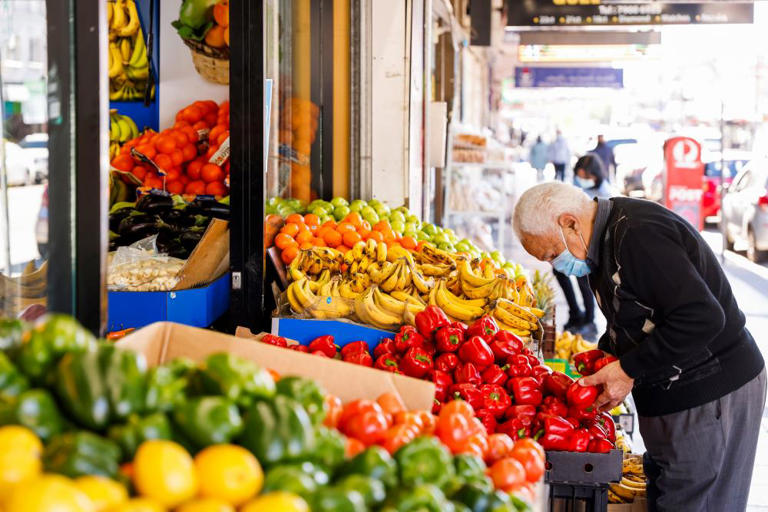Source: The Guardian
A Queensland shopper this week spotted iceberg lettuce selling at a supermarket for $11.99. The photo quickly went viral as evidence of the cost-of-living pressures Australians are facing.
Iceberg lettuce previously cost about $2.80 each, making it somewhat of an infamous star of inflation. So what has caused the price of the humble vegetable and other fresh produce to rise so sharply, and how long will the high prices last?
Which vegetables are going up?
It’s not just iceberg lettuce, as few products escape the effects of steep inflation. The latest consumer price index figures show a 12.7% year-on-year increase in the cost of vegetables.
In the last six months, a comparative shop shows a kilo of sweet potatoes jumped from $1.88 to $4.24. The cost of continental cucumbers more than doubled – going from $1.50 each to $3.50 each.
A comparison of prices from one shop done last August show similar jumps. A bag of brown onions went from $2.00 a kilo to $2.90; a bunch of celery went from $3.00 to $4.50, and four zucchinis went from $2.94 to $4.68.
Back in 2018, broccoli was $3.90 a kg, but is now $9.90.
In Sydney, a recent photo of capsicums at Harris Farm retailing for $18.99 a kilo went viral; in Melbourne, a Kent pumpkin will set you back $15.60, while a watermelon – out of season though from Australia – costs $25.52.
Almost everything is going up, from truss tomatoes to zucchinis. Michael Harvey, a senior analyst at Rabobank, said Australians had seen the highest price growth in 10 years.
“Clearly the numbers [from the March quarter] are the highest they’ve been in 10 years when you measure it quarterly,” he said. “They hadn’t been that high since 2011, when there was a cyclone that had a huge impact on bananas.”
“When you look under the hood it is broad-based: vegetables, beef, meat and dairy – seafood [too], but vegetables are significant.”
What’s causing the increase?
There are multiple issues causing the price hike but the main drivers are floods, war and the pandemic.
Tyson Cattle, a spokesperson for AusVeg, said the recent floods which ruined crops in northern NSW and Queensland are a major factor. He said the damage in the Lockyer valley had a particularly big impact.
“The Lockyer valley has been heavily hit by recent weather events. That’s leading to a sharp price increase, particularly for fresh vegetables,” Cattle said.
“Lockyer is a significant growing region for all fresh vegetables. You could throw a dart at a board [covered in vegetables] and chances are it will hit one grown there.
At this time of year, the rest of the country eats vegetables coming from there, he said.
“That’s why we talk region-specific, rather than commodity-specific. You’ve got a heavier growing region at a really critical time and they’re hammered by rain events and floods.
“In Victoria and NSW, we rely heavily on Queensland supply, it’s warmer up there. You can’t pick anything in Vic at the moment because it’s 3 degrees outside.”
It’s not just domestic issues – prices are also connected to global events. Fertiliser, for instance, is up 120% from 24 months ago.
“When you zoom out, there is pressure across the food system from the farm gate to manufacturing,” Harvey said.
“That’s where the global events have an impact on pricing.”
The war in Ukraine and lockdowns in China are all creating a price hike for farmers.
“When you look at global events, these are short to medium-term impacts. The war in Ukraine impacts the cost of energy, fertiliser, grains and oilseeds.
“Even the lockdown in China is having an impact on the global supply chain. Pandemic-related costs are still in the food system.”
So how long will it last?
Consumers should brace themselves, Cattle said.
“Consumers need to understand prices won’t go back to the way they were. That’s to do with various things every Australian is dealing with, like high fuel costs,” he said.
“We won’t put number on how high prices will go. Market forces will determine that, retailers will determine that, not us.”
Harvey said there was more hip-pocket pain coming soon, but some domestic drivers could ease off within the next 12 months.
“We caution there is still some elevation on the horizon,” he said. “We would be suggesting to consumers there’ll be more coming down the pipeline.
“Over the next 12 months, if we have better growing conditions, improved labour availability [and] less supply chain disruptions, you will see lower inflation coming through.”
What can you do?
Shop around, check the frozen veggie aisle and try to find savings elsewhere, Harvey said.
“There aren’t a lot of levers, so brace for it,” he said.
“You can look for the items that aren’t seeing huge inflation, look for value offerings. Not everything is going up in price, some will still be affordable and tighten the belt a little bit on discretionary items.
“Significant global events are at play,’ he said. “It will pass, but it’s not a quick cycle.”












